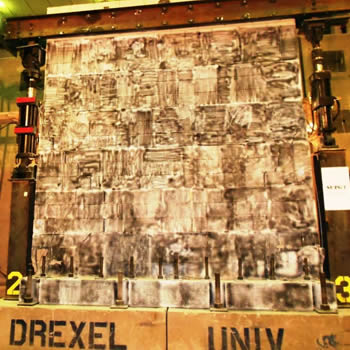 A multi-disciplinary team of engineering faculty and students of the CAEE and MEM Departments have been actively working in the Hess Laboratories at 34th and Ludlow Streets on large-scale testing to establish the seismic performance of a building structural system used throughout the U.S. The project is funded by a $1.5 million National Science Foundation (NSF) research grant entitled: “NEESR: Seismic Performance and Design of Partially-Grouted Reinforced Masonry Buildings.” The primary motivation for the project was a 2009 Drexel-led pilot study that uncovered a potentially significant seismic safety issue associated with the widely used and economically competitive building construction approach. Drexel project leaders, Drs. Ahmad Hamid and Franklin Moon, are collaborating with faculty from the University of California-San Diego and the University of Minnesota.
A multi-disciplinary team of engineering faculty and students of the CAEE and MEM Departments have been actively working in the Hess Laboratories at 34th and Ludlow Streets on large-scale testing to establish the seismic performance of a building structural system used throughout the U.S. The project is funded by a $1.5 million National Science Foundation (NSF) research grant entitled: “NEESR: Seismic Performance and Design of Partially-Grouted Reinforced Masonry Buildings.” The primary motivation for the project was a 2009 Drexel-led pilot study that uncovered a potentially significant seismic safety issue associated with the widely used and economically competitive building construction approach. Drexel project leaders, Drs. Ahmad Hamid and Franklin Moon, are collaborating with faculty from the University of California-San Diego and the University of Minnesota.
The three-year project, which began in June 2012, recently completed the first of thirteen full-scale structural wall tests in the Hess Laboratories. The specific specimens subjected to controlled, destructive testing are the largest of their kind ever experimentally tested. The results of this initial experiment support the findings of the pilot study. The wall resisted 43,000 pounds of lateral force while the current International Building Code (adopted throughout the U.S.) estimates the lateral-load capacity at 75,000 pounds, nearly 75% greater than measured. Given the observed and significant seismic vulnerability, the secondary objective of the project, which is to develop and validate economically competitive design details and retrofit methods to ensure such structural walls have sufficient seismic safety, has become a major focus of the effort.
 In addition to the focus on seismic safety, this project has offered faculty a unique opportunity to validate novel sensing systems on full-scale structural components under destructive force levels. CAEE Assistant Professor Dr. Ivan Bartoli and MEM Assistant Professor Dr. Antonios Konstos implemented innovative sensing approaches during the initial experiment, including Acoustic Emission (ultrasonic sensors capable of detecting structural cracking), Digital Image Correlation (high resolution images capable of establishing full-field displacement fields), and Thermography (thermal images capable of measuring both construction quality and structural damage). These non-invasive sensing approaches hold enormous potential for the rapid safety assessment of buildings and other civil infrastructure. The large-scale validation currently being carried out at the Hess Laboratories is both unique and illustrative of the potential of multi-disciplinary research efforts.
In addition to the focus on seismic safety, this project has offered faculty a unique opportunity to validate novel sensing systems on full-scale structural components under destructive force levels. CAEE Assistant Professor Dr. Ivan Bartoli and MEM Assistant Professor Dr. Antonios Konstos implemented innovative sensing approaches during the initial experiment, including Acoustic Emission (ultrasonic sensors capable of detecting structural cracking), Digital Image Correlation (high resolution images capable of establishing full-field displacement fields), and Thermography (thermal images capable of measuring both construction quality and structural damage). These non-invasive sensing approaches hold enormous potential for the rapid safety assessment of buildings and other civil infrastructure. The large-scale validation currently being carried out at the Hess Laboratories is both unique and illustrative of the potential of multi-disciplinary research efforts.
CAEE doctoral student Mohammad Bolhassani and CAEE lab technician Greg Hilley have been overseeing project set-up in Hess. Former doctoral student and current Pennoni employee, Ehsan Minaie has provided assistance with effort.
